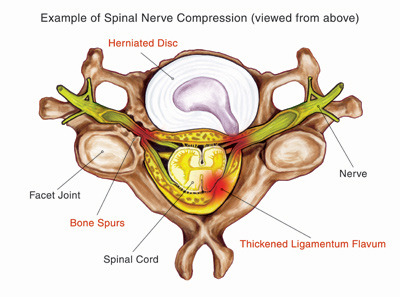Spinal stenosis refers to the narrowing of the spinal canal and the reduction in size of the openings in the bony vertebral canal through which nerves can exit and branch out. Spinal stenosis can be associated with:
- The aging process and degeneration of the spine
- Development of bone spurs along the spine
- Arthritis that can enlarge and inflame joints
- Spondylolisthesis
- Thickening ligaments
- Injury to the back
- Tumors
- Dwarfism
Stenosis Symptoms
Stenosis can occur at any point along the spine. Symptoms can vary somewhat based on the level of the spine where the stenosis occurs.
Cervical stenosis (neck)
- Neck pain
- Pain, weakness or numbness in the shoulders, arms, or hands
- Impaired motor function (especially manual coordination)
- Difficulty with balance or walking
Lumbar stenosis (lower back)
- Back pain
- Pain, weakness or numbness in the buttocks and legs
- Difficulty walking or standing for long periods
- Pain that can be relieved by sitting down or leaning forward
- Foot problems
Diagnosing Stenosis
Any of the above symptoms should be discussed with a qualified physician, who will likely conduct a physical exam and take a detailed medical history. Imaging scans may be required to diagnose stenosis.
Typically, stenosis starts gradually and worsens over time. Stenosis will not improve or go away on its own.
Treatment of Stenosis
Fortunately, there are effective ways to treat stenosis. Conservative treatments include medication to control pain and inflammation along with physical therapy. Sometimes steroid injections are recommended.
Surgery may also be used to treat stenosis. Surgery is not appropriate for everyone. For those who may consider surgery for stenosis, there are minimally invasive approaches that can help decompress nerves (and relieve pain) which can be done using only a small incision. A type of minimally surgery for spinal surgery is decompressive laminectomy, which removes some of the bony growths of the vertebrae to create more room and allow nerves to decompress. this type of surgery may be combined with a spinal fusion procedure to help stabilize the spine.
The course of treatment for stenosis is highly individual and depends on the patient’s overall condition, age, severity of the stenosis, and personal preferences.s
Important!
Although very rare, sometimes people with stenosis may experience loss of bowel or bladder control or loss of feeling or extreme weakness in one or both legs. Seek emergency medical help at once if this occurs as this is a sign of cauda equina syndrome. Cauda equina syndrome may be life threatening.

